Overview
- Brief Narrative
- Fragment of an upper denture, likely recovered from a temporary pit furnace at Chelmno killing center in German-occupied Poland, during an archaeological excavation in 1986 and 1987. Killing operations at Chelmno commenced on December 8, 1941. Prisoners were taken to a camp at a manor house (Schlosslager) in the village to undress and relinquish their valuables. They were then loaded into a gas van where they were killed. The van was then driven 2.5 miles northwest of the village to a camp in the Rzuchowski forest (Waldlager), where the bodies were dumped into mass graves. The large number of corpses created a threat of disease and discovery by Allied forces, so the bodies were exhumed and burned in seven primitive pit furnaces. In the fall of 1942, the furnaces were replaced with two open-air crematoria consisting of concrete foundations topped by a grate of train rails. In March 1943, transports to Chelmno stopped, and the manor house and open-air crematoria in the forest were demolished. Deportations to Chelmno resumed from June to July 1944, to facilitate the liquidation of the Łódź ghetto. In this second phase, the entire killing process was carried out in the forest camp (Waldlager), necessitating the construction of new buildings. The Germans abandoned the camp on January 17, 1945, having killed over 172,000 people. The excavations of 1986-87, and later work have identified additional furnaces, crematoria, and mass graves at the site.
- Date
-
use:
before 1942 September
recovered: 1986-1987
- Geography
-
recovery:
Chelmno (Concentration camp);
Chełmno (Koło, Poland)
- Credit Line
- United States Holocaust Memorial Museum Collection, Gift of Muzeum Okręgowe w Koninie
- Markings
- top, center, machine-stamped : POPULAR
front, right, tooth indentations, machine-stamped : P / 3D / 4(?)
Physical Details
- Language
- English
- Classification
-
Tools and Equipment
- Category
-
Medical equipment
- Object Type
-
Partial dentures (lcsh)
- Genre/Form
- Teeth.
- Physical Description
- Fragment of an upper denture from a maxillary arch with five, off-white porcelain teeth. The base or support for the teeth is made of a dark reddish-orange, hard rubber, molded to follow the curved contours of the upper gum and jaw. The right half of the denture has broken off, leaving a jagged edge along the thin, slightly convex, central portion or palate. While being worn, this portion would rest against the upper palate in the mouth. Along the front and sides of the denture’s palate is the perpendicular gumline, a narrow band that has several arched notches for the teeth cut into the smooth surface. The arches are closely spaced, with four incisors — narrow teeth with thin, flat bottom edges — set into the front. These are followed by five empty arches for teeth that are now missing: one canine, two premolars, and two molars. At back of the gum is a wide molar with a flat base. The gum has smooth, rounded, top edges that are thin at the front and thicken as they curve toward the back. The back edge of the denture is thin, smooth, and rounded. The upper portion of the gum, above the empty notches, is broken, and the molded rubber has cracked away along the canine and premolar arches, exposing a dark, silver-colored metal interior. The teeth are discolored from use, and the base is soiled overall. The right half of the denture, which supported six porcelain teeth, is now missing.
- Dimensions
- overall: Height: 0.500 inches (1.27 cm) | Width: 1.750 inches (4.445 cm) | Depth: 1.875 inches (4.763 cm)
- Materials
- overall : rubber, porcelain, metal, ink
- Inscription
- bottom, back right, handwritten, black ink : CHO 40
Rights & Restrictions
- Conditions on Access
- No restrictions on access
- Conditions on Use
- No restrictions on use
Keywords & Subjects
- Topical Term
- Archaeology and history. Crematoriums--Poland. Execution sites--Excavation--Material culture. Executions and executioners--Poland--History. Exhumation--Cremation--Poland. Gas vans (Gas chambers)--Poland. Genocide. Mass burials--Poland. World War, 1939-1945--Occupied territories.
- Geographic Name
- Chełmno (Koło, Poland) Rzuchowa (Poland)
Administrative Notes
- Legal Status
- Permanent Collection
- Provenance
- The denture fragment was donated to the United States Holocaust Memorial Museum in 1989 by the Muzeum Okręgowe w Koninie.
- Record last modified:
- 2024-07-15 16:30:16
- This page:
- https://collections.ushmm.org/search/catalog/irn1100
Download & Licensing
In-Person Research
- By Appointment
- Request 21 Days in Advance of Visit
- Plan a Research Visit
- Request to See This Object
Contact Us
Also in Muzeum Okregowe w Konine collection
The collection consists of concrete, a map, utensils, clothing accessories, and other small personal artifacts recovered from the site of Chelmno killing center operated by the German SS and police authorities in German-occupied Poland.
Date: 1941-1945
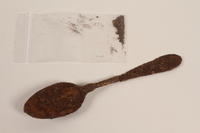
Rusted tablespoon recovered from Chelmno killing center
Object
Metal tablespoon, likely recovered from a temporary pit furnace at Chelmno killing center in German-occupied Poland, during an archaeological excavation in 1986 and 1987. Killing operations at Chelmno commenced on December 8, 1941. Prisoners were taken to a camp at a manor house (Schlosslager) in the village to undress and relinquish their valuables. They were then loaded into a gas van where they were killed. The van was then driven 2.5 miles northwest of the village to a camp in the Rzuchowski forest (Waldlager), where the bodies were dumped into mass graves. The large number of corpses created a threat of disease and discovery by Allied forces, so the bodies were exhumed and burned in seven primitive pit furnaces. In the fall of 1942, the furnaces were replaced with two open-air crematoria consisting of concrete foundations topped by a grate of train rails. In March 1943, transports to Chelmno stopped, and the manor house and open-air crematoria in the forest were demolished. Deportations to Chelmno resumed from June to July 1944, to facilitate the liquidation of the Łódź ghetto. In this second phase, the entire killing process was carried out in the forest camp (Waldlager), necessitating the construction of new buildings. The Germans abandoned the camp on January 17, 1945, having killed over 172,000 people. The excavations of 1986-87, and later work have identified additional furnaces, crematoria, and mass graves at the site.
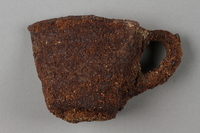
Rusted, crushed cup recovered from Chelmno killing center
Object
Metal cup, likely recovered from a temporary pit furnace at Chelmno killing center in German-occupied Poland, during an archaeological excavation in 1986 and 1987. Killing operations at Chelmno commenced on December 8, 1941. Prisoners were taken to a camp at a manor house (Schlosslager) in the village to undress and relinquish their valuables. They were then loaded into a gas van where they were killed. The van was then driven 2.5 miles northwest of the village to a camp in the Rzuchowski forest (Waldlager), where the bodies were dumped into mass graves. The large number of corpses created a threat of disease and discovery by Allied forces, so the bodies were exhumed and burned in seven primitive pit furnaces. In the fall of 1942, the furnaces were replaced with two open-air crematoria consisting of concrete foundations topped by a grate of train rails. In March 1943, transports to Chelmno stopped, and the manor house and open-air crematoria in the forest were demolished. Deportations to Chelmno resumed from June to July 1944, to facilitate the liquidation of the Łódź ghetto. In this second phase, the entire killing process was carried out in the forest camp (Waldlager), necessitating the construction of new buildings. The Germans abandoned the camp on January 17, 1945, having killed over 172,000 people. The excavations of 1986-87, and later work have identified additional furnaces, crematoria, and mass graves at the site.
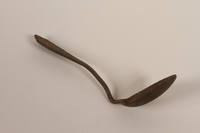
Metal teaspoon recovered from Chelmno killing center
Object
Metal teaspoon, likely recovered from a temporary pit furnace at Chelmno killing center in German-occupied Poland, during an archaeological excavation in 1986 and 1987. Killing operations at Chelmno commenced on December 8, 1941. Prisoners were taken to a camp at a manor house (Schlosslager) in the village to undress and relinquish their valuables. They were then loaded into a gas van where they were killed. The van was then driven 2.5 miles northwest of the village to a camp in the Rzuchowski forest (Waldlager), where the bodies were dumped into mass graves. The large number of corpses created a threat of disease and discovery by Allied forces, so the bodies were exhumed and burned in seven primitive pit furnaces. In the fall of 1942, the furnaces were replaced with two open-air crematoria consisting of concrete foundations topped by a grate of train rails. In March 1943, transports to Chelmno stopped, and the manor house and open-air crematoria in the forest were demolished. Deportations to Chelmno resumed from June to July 1944, to facilitate the liquidation of the Łódź ghetto. In this second phase, the entire killing process was carried out in the forest camp (Waldlager), necessitating the construction of new buildings. The Germans abandoned the camp on January 17, 1945, having killed over 172,000 people. The excavations of 1986-87, and later work have identified additional furnaces, crematoria, and mass graves at the site.
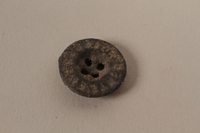
Small metal button recovered from Chelmno killing center
Object
Metal button, likely recovered from a temporary pit furnace at Chelmno killing center in German-occupied Poland, during an archaeological excavation in 1986 and 1987. Killing operations at Chelmno commenced on December 8, 1941. Prisoners were taken to a camp at a manor house (Schlosslager) in the village to undress and relinquish their valuables. They were then loaded into a gas van where they were killed. The van was then driven 2.5 miles northwest of the village to a camp in the Rzuchowski forest (Waldlager), where the bodies were dumped into mass graves. The large number of corpses created a threat of disease and discovery by Allied forces, so the bodies were exhumed and burned in seven primitive pit furnaces. In the fall of 1942, the furnaces were replaced with two open-air crematoria consisting of concrete foundations topped by a grate of train rails. In March 1943, transports to Chelmno stopped, and the manor house and open-air crematoria in the forest were demolished. Deportations to Chelmno resumed from June to July 1944, to facilitate the liquidation of the Łódź ghetto. In this second phase, the entire killing process was carried out in the forest camp (Waldlager), necessitating the construction of new buildings. The Germans abandoned the camp on January 17, 1945, having killed over 172,000 people. The excavations of 1986-87, and later work have identified additional furnaces, crematoria, and mass graves at the site.
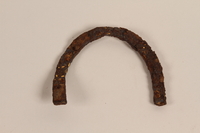
Rusted horseshoe-shaped heelplate recovered from Chelmno killing center
Object
Metal heel plate, likely recovered from a temporary pit furnace at Chelmno killing center in German-occupied Poland, during an archaeological excavation in 1986 and 1987. Killing operations at Chelmno commenced on December 8, 1941. Prisoners were taken to a camp at a manor house (Schlosslager) in the village to undress and relinquish their valuables. They were then loaded into a gas van where they were killed. The van was then driven 2.5 miles northwest of the village to a camp in the Rzuchowski forest (Waldlager), where the bodies were dumped into mass graves. The large number of corpses created a threat of disease and discovery by Allied forces, so the bodies were exhumed and burned in seven primitive pit furnaces. In the fall of 1942, the furnaces were replaced with two open-air crematoria consisting of concrete foundations topped by a grate of train rails. In March 1943, transports to Chelmno stopped, and the manor house and open-air crematoria in the forest were demolished. Deportations to Chelmno resumed from June to July 1944, to facilitate the liquidation of the Łódź ghetto. In this second phase, the entire killing process was carried out in the forest camp (Waldlager), necessitating the construction of new buildings. The Germans abandoned the camp on January 17, 1945, having killed over 172,000 people. The excavations of 1986-87, and later work have identified additional furnaces, crematoria, and mass graves at the site.

Rusted heel plate with screw recovered from Chelmno killing center
Object
Metal heel plate, likely recovered from a temporary pit furnace at Chelmno killing center in German-occupied Poland, during an archaeological excavation in 1986 and 1987. Killing operations at Chelmno commenced on December 8, 1941. Prisoners were taken to a camp at a manor house (Schlosslager) in the village to undress and relinquish their valuables. They were then loaded into a gas van where they were killed. The van was then driven 2.5 miles northwest of the village to a camp in the Rzuchowski forest (Waldlager), where the bodies were dumped into mass graves. The large number of corpses created a threat of disease and discovery by Allied forces, so the bodies were exhumed and burned in seven primitive pit furnaces. In the fall of 1942, the furnaces were replaced with two open-air crematoria consisting of concrete foundations topped by a grate of train rails. In March 1943, transports to Chelmno stopped, and the manor house and open-air crematoria in the forest were demolished. Deportations to Chelmno resumed from June to July 1944, to facilitate the liquidation of the Łódź ghetto. In this second phase, the entire killing process was carried out in the forest camp (Waldlager), necessitating the construction of new buildings. The Germans abandoned the camp on January 17, 1945, having killed over 172,000 people. The excavations of 1986-87, and later work have identified additional furnaces, crematoria, and mass graves at the site.

Metal tailor's thimble recovered from Chelmno killing center
Object
Metal thimble, likely recovered from a temporary pit furnace at Chelmno killing center in German-occupied Poland, during an archaeological excavation in 1986 and 1987. Killing operations at Chelmno commenced on December 8, 1941. Prisoners were taken to a camp at a manor house (Schlosslager) in the village to undress and relinquish their valuables. They were then loaded into a gas van where they were killed. The van was then driven 2.5 miles northwest of the village to a camp in the Rzuchowski forest (Waldlager), where the bodies were dumped into mass graves. The large number of corpses created a threat of disease and discovery by Allied forces, so the bodies were exhumed and burned in seven primitive pit furnaces. In the fall of 1942, the furnaces were replaced with two open-air crematoria consisting of concrete foundations topped by a grate of train rails. In March 1943, transports to Chelmno stopped, and the manor house and open-air crematoria in the forest were demolished. Deportations to Chelmno resumed from June to July 1944, to facilitate the liquidation of the Łódź ghetto. In this second phase, the entire killing process was carried out in the forest camp (Waldlager), necessitating the construction of new buildings. The Germans abandoned the camp on January 17, 1945, having killed over 172,000 people. The excavations of 1986-87, and later work have identified additional furnaces, crematoria, and mass graves at the site.
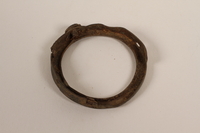
Partial pocket watch casing recovered from Chelmno killing center
Object
Partial pocket watch casing, likely recovered from a temporary pit furnace at Chelmno killing center in German-occupied Poland, during an archaeological excavation in 1986 and 1987. Killing operations at Chelmno commenced on December 8, 1941. Prisoners were taken to a camp at a manor house (Schlosslager) in the village to undress and relinquish their valuables. They were then loaded into a gas van where they were killed. The van was then driven 2.5 miles northwest of the village to a camp in the Rzuchowski forest (Waldlager), where the bodies were dumped into mass graves. The large number of corpses created a threat of disease and discovery by Allied forces, so the bodies were exhumed and burned in seven primitive pit furnaces. In the fall of 1942, the furnaces were replaced with two open-air crematoria consisting of concrete foundations topped by a grate of train rails. In March 1943, transports to Chelmno stopped, and the manor house and open-air crematoria in the forest were demolished. Deportations to Chelmno resumed from June to July 1944, to facilitate the liquidation of the Łódź ghetto. In this second phase, the entire killing process was carried out in the forest camp (Waldlager), necessitating the construction of new buildings. The Germans abandoned the camp on January 17, 1945, having killed over 172,000 people. The excavations of 1986-87, and later work have identified additional furnaces, crematoria, and mass graves at the site.

Partial button recovered from Chelmno killing center
Object
Partial button, likely recovered from a temporary pit furnace at Chelmno killing center in German-occupied Poland, during an archaeological excavation in 1986 and 1987. Killing operations at Chelmno commenced on December 8, 1941. Prisoners were taken to a camp at a manor house (Schlosslager) in the village to undress and relinquish their valuables. They were then loaded into a gas van where they were killed. The van was then driven 2.5 miles northwest of the village to a camp in the Rzuchowski forest (Waldlager), where the bodies were dumped into mass graves. The large number of corpses created a threat of disease and discovery by Allied forces, so the bodies were exhumed and burned in seven primitive pit furnaces. In the fall of 1942, the furnaces were replaced with two open-air crematoria consisting of concrete foundations topped by a grate of train rails. In March 1943, transports to Chelmno stopped, and the manor house and open-air crematoria in the forest were demolished. Deportations to Chelmno resumed from June to July 1944, to facilitate the liquidation of the Łódź ghetto. In this second phase, the entire killing process was carried out in the forest camp (Waldlager), necessitating the construction of new buildings. The Germans abandoned the camp on January 17, 1945, having killed over 172,000 people. The excavations of 1986-87, and later work have identified additional furnaces, crematoria, and mass graves at the site.
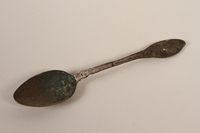
Metal teaspoon recovered from Chelmno killing center
Object
Metal teaspoon, likely recovered from a temporary pit furnace at Chelmno killing center in German-occupied Poland, during an archaeological excavation in 1986 and 1987. Killing operations at Chelmno commenced on December 8, 1941. Prisoners were taken to a camp at a manor house (Schlosslager) in the village to undress and relinquish their valuables. They were then loaded into a gas van where they were killed. The van was then driven 2.5 miles northwest of the village to a camp in the Rzuchowski forest (Waldlager), where the bodies were dumped into mass graves. The large number of corpses created a threat of disease and discovery by Allied forces, so the bodies were exhumed and burned in seven primitive pit furnaces. In the fall of 1942, the furnaces were replaced with two open-air crematoria consisting of concrete foundations topped by a grate of train rails. In March 1943, transports to Chelmno stopped, and the manor house and open-air crematoria in the forest were demolished. Deportations to Chelmno resumed from June to July 1944, to facilitate the liquidation of the Łódź ghetto. In this second phase, the entire killing process was carried out in the forest camp (Waldlager), necessitating the construction of new buildings. The Germans abandoned the camp on January 17, 1945, having killed over 172,000 people. The excavations of 1986-87, and later work have identified additional furnaces, crematoria, and mass graves at the site.
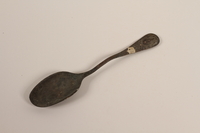
Metal tablespoon recovered from Chelmno killing center
Object
Metal tablespoon, likely recovered from a temporary pit furnace at Chelmno killing center in German-occupied Poland, during an archaeological excavation in 1986 and 1987. Killing operations at Chelmno commenced on December 8, 1941. Prisoners were taken to a camp at a manor house (Schlosslager) in the village to undress and relinquish their valuables. They were then loaded into a gas van where they were killed. The van was then driven 2.5 miles northwest of the village to a camp in the Rzuchowski forest (Waldlager), where the bodies were dumped into mass graves. The large number of corpses created a threat of disease and discovery by Allied forces, so the bodies were exhumed and burned in seven primitive pit furnaces. In the fall of 1942, the furnaces were replaced with two open-air crematoria consisting of concrete foundations topped by a grate of train rails. In March 1943, transports to Chelmno stopped, and the manor house and open-air crematoria in the forest were demolished. Deportations to Chelmno resumed from June to July 1944, to facilitate the liquidation of the Łódź ghetto. In this second phase, the entire killing process was carried out in the forest camp (Waldlager), necessitating the construction of new buildings. The Germans abandoned the camp on January 17, 1945, having killed over 172,000 people. The excavations of 1986-87, and later work have identified additional furnaces, crematoria, and mass graves at the site.

Bent, rusted teaspoon recovered from Chelmno killing center
Object
Metal teaspoon, likely recovered from a temporary pit furnace at Chelmno killing center in German-occupied Poland, during an archaeological excavation in 1986 and 1987. Killing operations at Chelmno commenced on December 8, 1941. Prisoners were taken to a camp at a manor house (Schlosslager) in the village to undress and relinquish their valuables. They were then loaded into a gas van where they were killed. The van was then driven 2.5 miles northwest of the village to a camp in the Rzuchowski forest (Waldlager), where the bodies were dumped into mass graves. The large number of corpses created a threat of disease and discovery by Allied forces, so the bodies were exhumed and burned in seven primitive pit furnaces. In the fall of 1942, the furnaces were replaced with two open-air crematoria consisting of concrete foundations topped by a grate of train rails. In March 1943, transports to Chelmno stopped, and the manor house and open-air crematoria in the forest were demolished. Deportations to Chelmno resumed from June to July 1944, to facilitate the liquidation of the Łódź ghetto. In this second phase, the entire killing process was carried out in the forest camp (Waldlager), necessitating the construction of new buildings. The Germans abandoned the camp on January 17, 1945, having killed over 172,000 people. The excavations of 1986-87, and later work have identified additional furnaces, crematoria, and mass graves at the site.

Porcelain and metal bottle stopper recovered from Chelmno killing center
Object
Porcelain bottle stopper, likely recovered from a temporary pit furnace at Chelmno killing center in German-occupied Poland, during an archaeological excavation in 1986 and 1987. Killing operations at Chelmno commenced on December 8, 1941. Prisoners were taken to a camp at a manor house (Schlosslager) in the village to undress and relinquish their valuables. They were then loaded into a gas van where they were killed. The van was then driven 2.5 miles northwest of the village to a camp in the Rzuchowski forest (Waldlager), where the bodies were dumped into mass graves. The large number of corpses created a threat of disease and discovery by Allied forces, so the bodies were exhumed and burned in seven primitive pit furnaces. In the fall of 1942, the furnaces were replaced with two open-air crematoria consisting of concrete foundations topped by a grate of train rails. In March 1943, transports to Chelmno stopped, and the manor house and open-air crematoria in the forest were demolished. Deportations to Chelmno resumed from June to July 1944, to facilitate the liquidation of the Łódź ghetto. In this second phase, the entire killing process was carried out in the forest camp (Waldlager), necessitating the construction of new buildings. The Germans abandoned the camp on January 17, 1945, having killed over 172,000 people. The excavations of 1986-87, and later work have identified additional furnaces, crematoria, and mass graves at the site.

Small metal key recovered from Chelmno killing center
Object
Metal key, likely recovered from a temporary pit furnace at Chelmno killing center in German-occupied Poland, during an archaeological excavation in 1986 and 1987. Killing operations at Chelmno commenced on December 8, 1941. Prisoners were taken to a camp at a manor house (Schlosslager) in the village to undress and relinquish their valuables. They were then loaded into a gas van where they were killed. The van was then driven 2.5 miles northwest of the village to a camp in the Rzuchowski forest (Waldlager), where the bodies were dumped into mass graves. The large number of corpses created a threat of disease and discovery by Allied forces, so the bodies were exhumed and burned in seven primitive pit furnaces. In the fall of 1942, the furnaces were replaced with two open-air crematoria consisting of concrete foundations topped by a grate of train rails. In March 1943, transports to Chelmno stopped, and the manor house and open-air crematoria in the forest were demolished. Deportations to Chelmno resumed from June to July 1944, to facilitate the liquidation of the Łódź ghetto. In this second phase, the entire killing process was carried out in the forest camp (Waldlager), necessitating the construction of new buildings. The Germans abandoned the camp on January 17, 1945, having killed over 172,000 people. The excavations of 1986-87, and later work have identified additional furnaces, crematoria, and mass graves at the site.
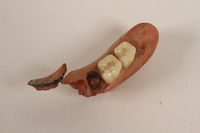
Partial lower plate of a denture with two molars recovered from Chelmno killing center
Object
Fragment of a lower denture, likely recovered from a temporary pit furnace at Chelmno killing center in German-occupied Poland, during an archaeological excavation in 1986 and 1987. Killing operations at Chelmno commenced on December 8, 1941. Prisoners were taken to a camp at a manor house (Schlosslager) in the village to undress and relinquish their valuables. They were then loaded into a gas van where they were killed. The van was then driven 2.5 miles northwest of the village to a camp in the Rzuchowski forest (Waldlager), where the bodies were dumped into mass graves. The large number of corpses created a threat of disease and discovery by Allied forces, so the bodies were exhumed and burned in seven primitive pit furnaces. In the fall of 1942, the furnaces were replaced with two open-air crematoria consisting of concrete foundations topped by a grate of train rails. In March 1943, transports to Chelmno stopped, and the manor house and open-air crematoria in the forest were demolished. Deportations to Chelmno resumed from June to July 1944, to facilitate the liquidation of the Łódź ghetto. In this second phase, the entire killing process was carried out in the forest camp (Waldlager), necessitating the construction of new buildings. The Germans abandoned the camp on January 17, 1945, having killed over 172,000 people. The excavations of 1986-87, and later work have identified additional furnaces, crematoria, and mass graves at the site.
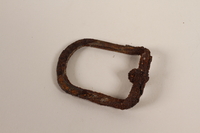
Metal buckle frame recovered from Chelmno killing center
Object
Metal buckle frame, likely recovered from a temporary pit furnace at Chelmno killing center in German-occupied Poland, during an archaeological excavation in 1986 and 1987. Killing operations at Chelmno commenced on December 8, 1941. Prisoners were taken to a camp at a manor house (Schlosslager) in the village to undress and relinquish their valuables. They were then loaded into a gas van where they were killed. The van was then driven 2.5 miles northwest of the village to a camp in the Rzuchowski forest (Waldlager), where the bodies were dumped into mass graves. The large number of corpses created a threat of disease and discovery by Allied forces, so the bodies were exhumed and burned in seven primitive pit furnaces. In the fall of 1942, the furnaces were replaced with two open-air crematoria consisting of concrete foundations topped by a grate of train rails. In March 1943, transports to Chelmno stopped, and the manor house and open-air crematoria in the forest were demolished. Deportations to Chelmno resumed from June to July 1944, to facilitate the liquidation of the Łódź ghetto. In this second phase, the entire killing process was carried out in the forest camp (Waldlager), necessitating the construction of new buildings. The Germans abandoned the camp on January 17, 1945, having killed over 172,000 people. The excavations of 1986-87, and later work have identified additional furnaces, crematoria, and mass graves at the site.

Metal horseshoe-shaped heel plate recovered from Chelmno killing center
Object
Metal heel plate, likely recovered from a temporary pit furnace at Chelmno killing center in German-occupied Poland, during an archaeological excavation in 1986 and 1987. Killing operations at Chelmno commenced on December 8, 1941. Prisoners were taken to a camp at a manor house (Schlosslager) in the village to undress and relinquish their valuables. They were then loaded into a gas van where they were killed. The van was then driven 2.5 miles northwest of the village to a camp in the Rzuchowski forest (Waldlager), where the bodies were dumped into mass graves. The large number of corpses created a threat of disease and discovery by Allied forces, so the bodies were exhumed and burned in seven primitive pit furnaces. In the fall of 1942, the furnaces were replaced with two open-air crematoria consisting of concrete foundations topped by a grate of train rails. In March 1943, transports to Chelmno stopped, and the manor house and open-air crematoria in the forest were demolished. Deportations to Chelmno resumed from June to July 1944, to facilitate the liquidation of the Łódź ghetto. In this second phase, the entire killing process was carried out in the forest camp (Waldlager), necessitating the construction of new buildings. The Germans abandoned the camp on January 17, 1945, having killed over 172,000 people. The excavations of 1986-87, and later work have identified additional furnaces, crematoria, and mass graves at the site.
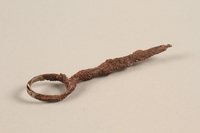
Small scissors in two pieces, recovered from Chelmno killing center
Object
Metal scissors, likely recovered from a temporary pit furnace at Chelmno killing center in German-occupied Poland, during an archaeological excavation in 1986 and 1987. Killing operations at Chelmno commenced on December 8, 1941. Prisoners were taken to a camp at a manor house (Schlosslager) in the village to undress and relinquish their valuables. They were then loaded into a gas van where they were killed. The van was then driven 2.5 miles northwest of the village to a camp in the Rzuchowski forest (Waldlager), where the bodies were dumped into mass graves. The large number of corpses created a threat of disease and discovery by Allied forces, so the bodies were exhumed and burned in seven primitive pit furnaces. In the fall of 1942, the furnaces were replaced with two open-air crematoria consisting of concrete foundations topped by a grate of train rails. In March 1943, transports to Chelmno stopped, and the manor house and open-air crematoria in the forest were demolished. Deportations to Chelmno resumed from June to July 1944, to facilitate the liquidation of the Łódź ghetto. In this second phase, the entire killing process was carried out in the forest camp (Waldlager), necessitating the construction of new buildings. The Germans abandoned the camp on January 17, 1945, having killed over 172,000 people. The excavations of 1986-87, and later work have identified additional furnaces, crematoria, and mass graves at the site.
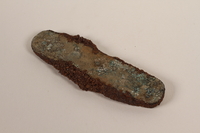
Rusted pocketknife recovered from Chelmno killing center
Object
Pocketknife, likely recovered from a temporary pit furnace at Chelmno killing center in German-occupied Poland, during an archaeological excavation in 1986 and 1987. Killing operations at Chelmno commenced on December 8, 1941. Prisoners were taken to a camp at a manor house (Schlosslager) in the village to undress and relinquish their valuables. They were then loaded into a gas van where they were killed. The van was then driven 2.5 miles northwest of the village to a camp in the Rzuchowski forest (Waldlager), where the bodies were dumped into mass graves. The large number of corpses created a threat of disease and discovery by Allied forces, so the bodies were exhumed and burned in seven primitive pit furnaces. In the fall of 1942, the furnaces were replaced with two open-air crematoria consisting of concrete foundations topped by a grate of train rails. In March 1943, transports to Chelmno stopped, and the manor house and open-air crematoria in the forest were demolished. Deportations to Chelmno resumed from June to July 1944, to facilitate the liquidation of the Łódź ghetto. In this second phase, the entire killing process was carried out in the forest camp (Waldlager), necessitating the construction of new buildings. The Germans abandoned the camp on January 17, 1945, having killed over 172,000 people. The excavations of 1986-87, and later work have identified additional furnaces, crematoria, and mass graves at the site.

Metal teaspoon recovered from Chelmno killing center
Object
Metal teaspoon, likely recovered from a temporary pit furnace at Chelmno killing center in German-occupied Poland, during an archaeological excavation in 1986 and 1987. Killing operations at Chelmno commenced on December 8, 1941. Prisoners were taken to a camp at a manor house (Schlosslager) in the village to undress and relinquish their valuables. They were then loaded into a gas van where they were killed. The van was then driven 2.5 miles northwest of the village to a camp in the Rzuchowski forest (Waldlager), where the bodies were dumped into mass graves. The large number of corpses created a threat of disease and discovery by Allied forces, so the bodies were exhumed and burned in seven primitive pit furnaces. In the fall of 1942, the furnaces were replaced with two open-air crematoria consisting of concrete foundations topped by a grate of train rails. In March 1943, transports to Chelmno stopped, and the manor house and open-air crematoria in the forest were demolished. Deportations to Chelmno resumed from June to July 1944, to facilitate the liquidation of the Łódź ghetto. In this second phase, the entire killing process was carried out in the forest camp (Waldlager), necessitating the construction of new buildings. The Germans abandoned the camp on January 17, 1945, having killed over 172,000 people. The excavations of 1986-87, and later work have identified additional furnaces, crematoria, and mass graves at the site.
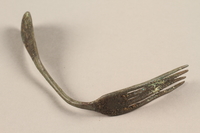
Bent metal fork recovered from Chelmno killing center
Object
Metal fork, likely recovered from a temporary pit furnace at Chelmno killing center in German-occupied Poland, during an archaeological excavation in 1986 and 1987. Killing operations at Chelmno commenced on December 8, 1941. Prisoners were taken to a camp at a manor house (Schlosslager) in the village to undress and relinquish their valuables. They were then loaded into a gas van where they were killed. The van was then driven 2.5 miles northwest of the village to a camp in the Rzuchowski forest (Waldlager), where the bodies were dumped into mass graves. The large number of corpses created a threat of disease and discovery by Allied forces, so the bodies were exhumed and burned in seven primitive pit furnaces. In the fall of 1942, the furnaces were replaced with two open-air crematoria consisting of concrete foundations topped by a grate of train rails. In March 1943, transports to Chelmno stopped, and the manor house and open-air crematoria in the forest were demolished. Deportations to Chelmno resumed from June to July 1944, to facilitate the liquidation of the Łódź ghetto. In this second phase, the entire killing process was carried out in the forest camp (Waldlager), necessitating the construction of new buildings. The Germans abandoned the camp on January 17, 1945, having killed over 172,000 people. The excavations of 1986-87, and later work have identified additional furnaces, crematoria, and mass graves at the site.
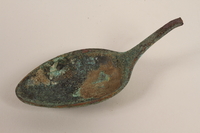
Metal tablespoon fragment recovered from Chelmno killing center
Object
Metal tablespoon, likely recovered from a temporary pit furnace at Chelmno killing center in German-occupied Poland, during an archaeological excavation in 1986 and 1987. Killing operations at Chelmno commenced on December 8, 1941. Prisoners were taken to a camp at a manor house (Schlosslager) in the village to undress and relinquish their valuables. They were then loaded into a gas van where they were killed. The van was then driven 2.5 miles northwest of the village to a camp in the Rzuchowski forest (Waldlager), where the bodies were dumped into mass graves. The large number of corpses created a threat of disease and discovery by Allied forces, so the bodies were exhumed and burned in seven primitive pit furnaces. In the fall of 1942, the furnaces were replaced with two open-air crematoria consisting of concrete foundations topped by a grate of train rails. In March 1943, transports to Chelmno stopped, and the manor house and open-air crematoria in the forest were demolished. Deportations to Chelmno resumed from June to July 1944, to facilitate the liquidation of the Łódź ghetto. In this second phase, the entire killing process was carried out in the forest camp (Waldlager), necessitating the construction of new buildings. The Germans abandoned the camp on January 17, 1945, having killed over 172,000 people. The excavations of 1986-87, and later work have identified additional furnaces, crematoria, and mass graves at the site.
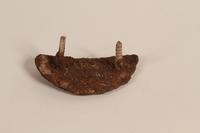
Rusted heel plate with a screw and nail recovered from Chelmno killing center
Object
Metal heel plate, likely recovered from a temporary pit furnace at Chelmno killing center in German-occupied Poland, during an archaeological excavation in 1986 and 1987. Killing operations at Chelmno commenced on December 8, 1941. Prisoners were taken to a camp at a manor house (Schlosslager) in the village to undress and relinquish their valuables. They were then loaded into a gas van where they were killed. The van was then driven 2.5 miles northwest of the village to a camp in the Rzuchowski forest (Waldlager), where the bodies were dumped into mass graves. The large number of corpses created a threat of disease and discovery by Allied forces, so the bodies were exhumed and burned in seven primitive pit furnaces. In the fall of 1942, the furnaces were replaced with two open-air crematoria consisting of concrete foundations topped by a grate of train rails. In March 1943, transports to Chelmno stopped, and the manor house and open-air crematoria in the forest were demolished. Deportations to Chelmno resumed from June to July 1944, to facilitate the liquidation of the Łódź ghetto. In this second phase, the entire killing process was carried out in the forest camp (Waldlager), necessitating the construction of new buildings. The Germans abandoned the camp on January 17, 1945, having killed over 172,000 people. The excavations of 1986-87, and later work have identified additional furnaces, crematoria, and mass graves at the site.
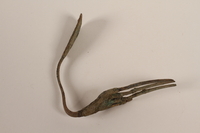
Metal fork recovered from Chelmno killing center
Object
Metal fork, likely recovered from a temporary pit furnace at Chelmno killing center in German-occupied Poland, during an archaeological excavation in 1986 and 1987. Killing operations at Chelmno commenced on December 8, 1941. Prisoners were taken to a camp at a manor house (Schlosslager) in the village to undress and relinquish their valuables. They were then loaded into a gas van where they were killed. The van was then driven 2.5 miles northwest of the village to a camp in the Rzuchowski forest (Waldlager), where the bodies were dumped into mass graves. The large number of corpses created a threat of disease and discovery by Allied forces, so the bodies were exhumed and burned in seven primitive pit furnaces. In the fall of 1942, the furnaces were replaced with two open-air crematoria consisting of concrete foundations topped by a grate of train rails. In March 1943, transports to Chelmno stopped, and the manor house and open-air crematoria in the forest were demolished. Deportations to Chelmno resumed from June to July 1944, to facilitate the liquidation of the Łódź ghetto. In this second phase, the entire killing process was carried out in the forest camp (Waldlager), necessitating the construction of new buildings. The Germans abandoned the camp on January 17, 1945, having killed over 172,000 people. The excavations of 1986-87, and later work have identified additional furnaces, crematoria, and mass graves at the site.
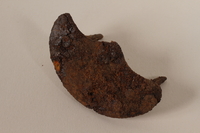
Corroded metal heel plate recovered from Chelmno killing center
Object
Metal heel plate, likely recovered from a temporary pit furnace at Chelmno killing center in German-occupied Poland, during an archaeological excavation in 1986 and 1987. Killing operations at Chelmno commenced on December 8, 1941. Prisoners were taken to a camp at a manor house (Schlosslager) in the village to undress and relinquish their valuables. They were then loaded into a gas van where they were killed. The van was then driven 2.5 miles northwest of the village to a camp in the Rzuchowski forest (Waldlager), where the bodies were dumped into mass graves. The large number of corpses created a threat of disease and discovery by Allied forces, so the bodies were exhumed and burned in seven primitive pit furnaces. In the fall of 1942, the furnaces were replaced with two open-air crematoria consisting of concrete foundations topped by a grate of train rails. In March 1943, transports to Chelmno stopped, and the manor house and open-air crematoria in the forest were demolished. Deportations to Chelmno resumed from June to July 1944, to facilitate the liquidation of the Łódź ghetto. In this second phase, the entire killing process was carried out in the forest camp (Waldlager), necessitating the construction of new buildings. The Germans abandoned the camp on January 17, 1945, having killed over 172,000 people. The excavations of 1986-87, and later work have identified additional furnaces, crematoria, and mass graves at the site.

Rusted, bent metal shoehorn recovered from Chelmno killing center
Object
Metal shoehorn, likely recovered from a temporary pit furnace at Chelmno killing center in German-occupied Poland, during an archaeological excavation in 1986 and 1987. Killing operations at Chelmno commenced on December 8, 1941. Prisoners were taken to a camp at a manor house (Schlosslager) in the village to undress and relinquish their valuables. They were then loaded into a gas van where they were killed. The van was then driven 2.5 miles northwest of the village to a camp in the Rzuchowski forest (Waldlager), where the bodies were dumped into mass graves. The large number of corpses created a threat of disease and discovery by Allied forces, so the bodies were exhumed and burned in seven primitive pit furnaces. In the fall of 1942, the furnaces were replaced with two open-air crematoria consisting of concrete foundations topped by a grate of train rails. In March 1943, transports to Chelmno stopped, and the manor house and open-air crematoria in the forest were demolished. Deportations to Chelmno resumed from June to July 1944, to facilitate the liquidation of the Łódź ghetto. In this second phase, the entire killing process was carried out in the forest camp (Waldlager), necessitating the construction of new buildings. The Germans abandoned the camp on January 17, 1945, having killed over 172,000 people. The excavations of 1986-87, and later work have identified additional furnaces, crematoria, and mass graves at the site.

Nail recovered from Chelmno killing center
Object
Metal nail, likely recovered from a temporary pit furnace at Chelmno killing center in German-occupied Poland, during an archaeological excavation in 1986 and 1987. Killing operations at Chelmno commenced on December 8, 1941. Prisoners were taken to a camp at a manor house (Schlosslager) in the village to undress and relinquish their valuables. They were then loaded into a gas van where they were killed. The van was then driven 2.5 miles northwest of the village to a camp in the Rzuchowski forest (Waldlager), where the bodies were dumped into mass graves. The large number of corpses created a threat of disease and discovery by Allied forces, so the bodies were exhumed and burned in seven primitive pit furnaces. In the fall of 1942, the furnaces were replaced with two open-air crematoria consisting of concrete foundations topped by a grate of train rails. In March 1943, transports to Chelmno stopped, and the manor house and open-air crematoria in the forest were demolished. Deportations to Chelmno resumed from June to July 1944, to facilitate the liquidation of the Łódź ghetto. In this second phase, the entire killing process was carried out in the forest camp (Waldlager), necessitating the construction of new buildings. The Germans abandoned the camp on January 17, 1945, having killed over 172,000 people. The excavations of 1986-87, and later work have identified additional furnaces, crematoria, and mass graves at the site.
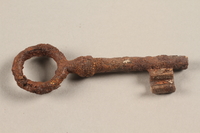
Large, rusted metal key recovered from Chelmno killing center
Object
Metal skeleton key, likely recovered from a temporary pit furnace at Chelmno killing center in German-occupied Poland, during an archaeological excavation in 1986 and 1987. Killing operations at Chelmno commenced on December 8, 1941. Prisoners were taken to a camp at a manor house (Schlosslager) in the village to undress and relinquish their valuables. They were then loaded into a gas van where they were killed. The van was then driven 2.5 miles northwest of the village to a camp in the Rzuchowski forest (Waldlager), where the bodies were dumped into mass graves. The large number of corpses created a threat of disease and discovery by Allied forces, so the bodies were exhumed and burned in seven primitive pit furnaces. In the fall of 1942, the furnaces were replaced with two open-air crematoria consisting of concrete foundations topped by a grate of train rails. In March 1943, transports to Chelmno stopped, and the manor house and open-air crematoria in the forest were demolished. Deportations to Chelmno resumed from June to July 1944, to facilitate the liquidation of the Łódź ghetto. In this second phase, the entire killing process was carried out in the forest camp (Waldlager), necessitating the construction of new buildings. The Germans abandoned the camp on January 17, 1945, having killed over 172,000 people. The excavations of 1986-87, and later work have identified additional furnaces, crematoria, and mass graves at the site.
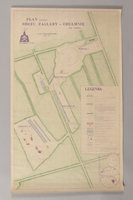
Map of the former extermination camp at Chelmno compiled by archaeologists excavating the site
Object
Hand-colored printed map of the forest camp of Chelmno killing center in German-occupied Poland, produced following archaeological excavations in 1986 and 1987. Killing operations at Chelmno were split between two locations, a manor house (Schlosslager) in the village and a camp in the Rzuchowski forest (Waldlager) 2.5 miles northwest of the village. The large number of corpses created a threat of disease and discovery by Allied forces, so the bodies were exhumed and burned in seven primitive pit furnaces. In the fall of 1942, the furnaces were replaced with two open-air crematoria consisting of concrete foundations topped by a grate of train rails. In March 1943, the manor house and open-air crematoria in the forest were demolished. Killing operations at Chelmno resumed from June to July 1944, and were carried out entirely in the forest camp, necessitating the construction of new buildings. The Germans abandoned the camp on January 17, 1945, having killed over 172,000 people. The map is a compilation of information from field photos taken in in 1958 and 1979; maps drawn in 1951, 1961, and 1987; and oral information from 1989. It identifies features found through archaeological excavations between 1951 and 1989. The excavations of 1986-87, and later work have identified additional furnaces, crematoria, and mass graves at the site.
Four eyeglass lenses recovered from Chelmno killing center
Object
Four eyeglass lenses, likely recovered from a temporary pit furnace at Chelmno killing center in German-occupied Poland, during an archaeological excavation in 1986 and 1987. Killing operations at Chelmno commenced on December 8, 1941. Prisoners were taken to a camp at a manor house (Schlosslager) in the village to undress and relinquish their valuables. They were then loaded into a gas van where they were killed. The van was then driven 2.5 miles northwest of the village to a camp in the Rzuchowski forest (Waldlager), where the bodies were dumped into mass graves. The large number of corpses created a threat of disease and discovery by Allied forces, so the bodies were exhumed and burned in seven primitive pit furnaces. In the fall of 1942, the furnaces were replaced with two open-air crematoria consisting of concrete foundations topped by a grate of train rails. In March 1943, transports to Chelmno stopped, and the manor house and open-air crematoria in the forest were demolished. Deportations to Chelmno resumed from June to July 1944, to facilitate the liquidation of the Łódź ghetto. In this second phase, the entire killing process was carried out in the forest camp (Waldlager), necessitating the construction of new buildings. The Germans abandoned the camp on January 17, 1945, having killed over 172,000 people. The excavations of 1986-87, and later work have identified additional furnaces, crematoria, and mass graves at the site.
Concrete remnants excavated from the crematorium at Chelmno killing center
Object
Concrete fragments recovered from a crematorium foundation at Chelmno killing center in German-occupied Poland, during an archaeological excavation in 1986 and 1987. Killing operations at Chelmno commenced on December 8, 1941. Prisoners were taken to a camp at a manor house (Schlosslager) in the village to undress and relinquish their valuables. They were then loaded into a gas van where they were killed. The van was then driven 2.5 miles northwest of the village to a camp in the Rzuchowski forest (Waldlager), where the bodies were dumped into mass graves. The large number of corpses created a threat of disease and discovery by Allied forces, so the bodies were exhumed and burned in seven primitive pit furnaces. In the fall of 1942, the furnaces were replaced with two open-air crematoria consisting of concrete foundations topped by a grate of train rails. The construction of the crematoria was overseen by an SS officer named Johannes Runge. In March 1943, transports to Chelmno stopped, and the manor house and open-air crematoria in the forest were demolished. Deportations to Chelmno resumed from June to July 1944 to facilitate the liquidation of the Łódź ghetto. In this second phase, the entire killing process was carried out in the forest camp, necessitating the construction of new buildings. The Germans abandoned the camp on January 17, 1945, having killed over 172,000 people. The excavations of 1986-87, and later work have identified additional furnaces, crematoria, and mass graves at the site.



